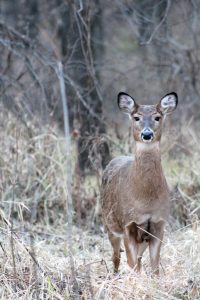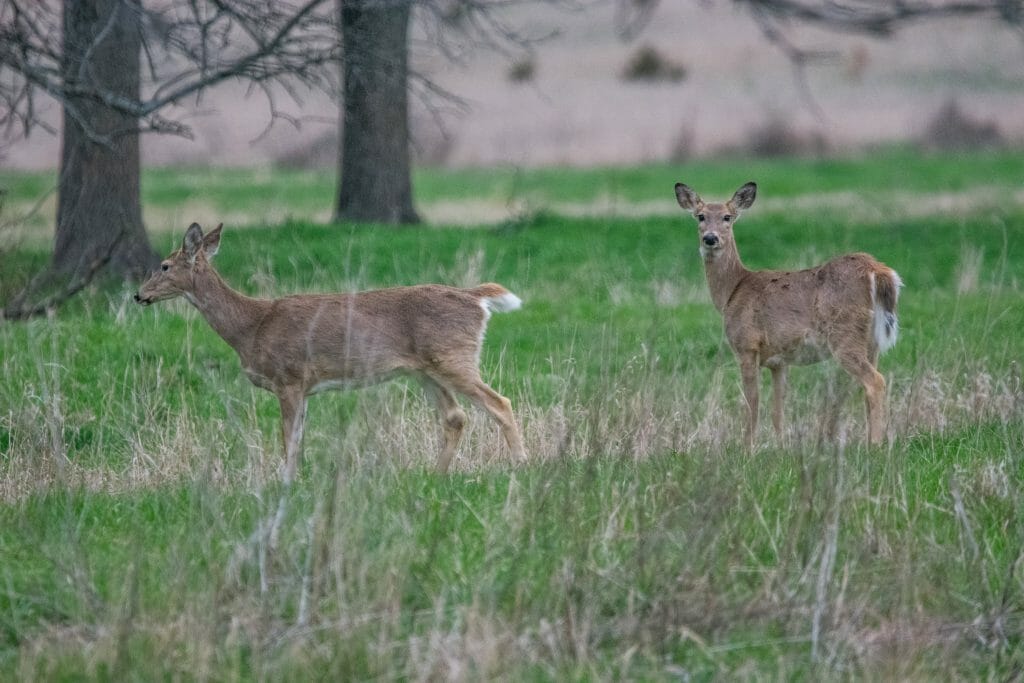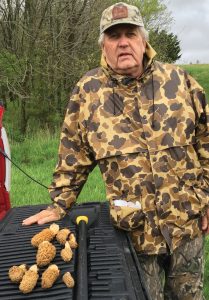Finding Value in Habitat
The edges, corners and nooks and crannies of a farm – the places where habitat is most likely to be found – may not be ideal for growing row crops, but these areas can still be ecologically and even economically productive.
If a landowner or farmer gets creative, she or he might find that on-farm habitat offers lucrative opportunities for alternative enterprises, like guiding or outfitting hunts, that can coexist with and even complement more traditional agricultural production.
One PFI member and landowner putting this idea into practice is Jim Freeland. With his wife Deborah, Jim owns farmland in southwest Iowa, northern Missouri and North Dakota, living half the year on a farm west of Corning, Iowa. They cash-rent their tillable ground and handle hay on shares, all fairly straightforward and traditional for an Iowa landowner. However, Jim also has over a dozen Conservation Reserve Program contracts on his farms, including buffer strips, wetlands and tree projects. These contracts and their associated rental payments start to generate some cash from habitat on the farms, but Jim has taken things a step further: he runs a deer and turkey hunting business offering experiences unique to rural Iowa. Through this business, Jim has hosted 35 to 40 out-of-state hunters each year for the last 20 years.
For most landowners, leasing or outfitting are the two main ways to make money from offering land to hunters. Jim’s approach is sort of a hybrid. He does not offer traditional annual hunting leases; instead he books small groups of hunters for specific periods of time, usually for a single hunting season, which is typically one to two weeks. But neither does Jim offer traditional outfitting services: no bedmaking, meals or guided hunts. Jim simply offers his customers a place to hunt on private land and a place to stay. This approach means he can charge significantly less than a normal outfitter-type experience, which makes his services more affordable for those who don’t want to pay for the outfitter experience or an annual hunting lease.
Connecting Clients to Rural Iowa

Catering to out-of-state deer hunters has proved to be more lucrative for Jim, and more affordable for clients.
The lodging Jim provides his hunters varies depending on which piece of land they are hunting on. For example, on one of his farms Jim purchased an old house and turned it into a lodge for his hunters to use. On another farm, he arranges housing with locals who have apartments or houses to rent. In general, he says, hunters don’t like to stay in motels. That suits Jim – one of his goals is to connect his out-of-state hunters to the local communities.
Jim gets his hunters involved with the local communities in a variety of ways. When asked where to get deer processed, he might point his hunters in the direction of a local locker. He also might introduce his hunters to a local person with an all-terrain vehicle – often his hunters will make an arrangement with that individual to help recover or transport deer. Jim might recommend restaurants, golf courses and bars, all local. And whenever he’s visiting with hunters, he makes a point to introduce them to local residents.
“If every farm built a little guest house, I believe you could fill it with hunters and agri-tourists half the year. I believe the average landowner could pay his or her property taxes with a hunting lease or something similar.”
– Jim Freeland
“I strongly believe that the hunters should get to know the locals,” Jim says. “They [the hunters] really like that strongly rural experience in Iowa, and so it’s good for the hunters and good for the communities.” Jim says many of his hunters like small towns and enjoy visiting rural Iowa, and he’s convinced there are unique opportunities for rural Iowa and businesses like his.
“If every farm built a little guest house, I believe you could fill it with hunters and agri-tourists half the year,” Jim says. “I believe the average landowner could pay his or her property taxes with a hunting lease or something similar.”
Nonresident hunters often get a bad rap in Iowa, and many Iowans are surprised when they learn Jim’s business only caters to hunters from out of state. Jim cites two main reasons for his decision. First, most resident hunters want annual leases, which he finds less lucrative than his current model. Second, despite the negative stereotypes associated with out-of-state hunters, Jim says he’s had good luck with his clients.
“Most nonresident hunters are great sportsmen,” he explains. He doesn’t get many true trophy hunters like other outfitters might; most of his hunters enjoy getting outside and spending time with each other experiencing rural Iowa. Generally, his hunters have lower expectations for the types of deer they’ll have a chance to take, which doesn’t mean they don’t get opportunities at trophy-class deer. But Jim generally doesn’t worry about things like antler restrictions, culling and age requirements, all of which are tactics to manage a deer herd for big antlers. Rather, he lets the hunters choose which deer to take and relies on his habitat and Iowa’s healthy whitetail populations to produce satisfying hunts.
Challenges
Like all businesses, Jim has challenges. “Deer hunting in Iowa could be a big industry,” he says, “but there are real limitations for out-of-state hunting licenses.” While out-of-state license fees help the Iowa Department of Natural Resources to manage and maintain a healthy deer population, the cost – almost $650 for an out-of-state or nonresident deer license – is prohibitive for many prospective customers. The licenses are also sold on a lottery system, and the odds of being selected for a nonresident license vary depending on the geographic zone you’re planning on hunting in.
Despite the complexity, Jim says it is possible to navigate the system. His hunters now come every other year: from a total pool of 70 customers, 30 to 35 may come in any given year. In their off years, his customers purchase a preference point, which significantly increases their chances of being selected for a license the following year.
This system has worked well in Jim’s area, but other parts of Iowa may be different depending on the demand (or lack thereof) for nonresident hunting licenses.
Other challenges include weather and disease. Hunting, like farming, depends on favorable weather for success; few people want to hunt during a severe cold snap or a blizzard, and Iowa’s popular shotgun deer seasons are in December. If the weather is poor, hunters may decide to cancel the trip or may not have an experience that makes them want to return the following year.
In 2012, and again in 2019, Iowa suffered significant outbreaks of epizootic hemorrhagic disease, killing thousands of deer across parts of Iowa. Although Jim says the outbreaks didn’t deter his hunters from coming to Iowa, they did impact his customers’ success rates and meant fewer deer sightings during their trips. The outbreak of other diseases, like chronic wasting disease, may pose similar challenges for Jim’s business.
Habitat as Economic Opportunity
Jim says that his hunting business influences him to care deeply about the habitat on his farms. Rather than seeing unproductive spaces, Jim sees quality habitat as a vital economic part of the farm. That view has some advantages, especially when Jim is looking to buy land. Where real estate agents and sellers might see “waste” areas (and price them as such), Jim says he sees economic opportunities.
He also doesn’t do much active management with things like food plots, instead relying on the natural habitat and the surrounding landscape to provide what the deer need. “I don’t really see a need for plots in Iowa,” Jim says. “Sometimes my hunters will pay their farmers or my tenants to leave crops in the field, which can serve a similar purpose. But generally food plots are only necessary if you’re trying to concentrate deer in front of a camera.”
Still, Jim doesn’t shy away from potential multiple benefits. “This year, we’re going to do cover crops on two farms,” he says. “We’re going to plant a mix of cereal rye, turnips and radishes.” While the cover crops will be an investment, even with some cost-share dollars, Jim feels the cost is worth it: The cover crops will help protect the soil from erosion, build soil health and serve as a de facto food plot. And that’s a win-win for everyone.



